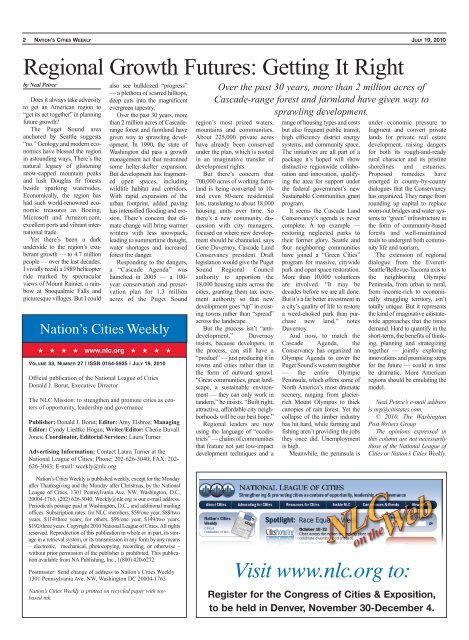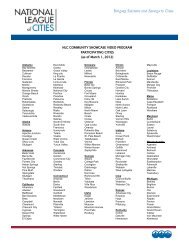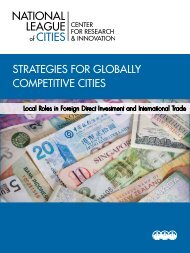NLC Board Discusses Immigration Policy, Gulf Oil Spill - National ...
NLC Board Discusses Immigration Policy, Gulf Oil Spill - National ...
NLC Board Discusses Immigration Policy, Gulf Oil Spill - National ...
You also want an ePaper? Increase the reach of your titles
YUMPU automatically turns print PDFs into web optimized ePapers that Google loves.
2 NATION’S CITIES WEEKLY JULY 19, 2010<br />
Regional Growth Futures: Getting It Right<br />
by Neal Peirce<br />
Does it always take adversity<br />
to get an American region to<br />
“get its act together” in planning<br />
future growth?<br />
The Puget Sound area<br />
anchored by Seattle suggests<br />
“no.” Geology and modern economics<br />
have blessed the region<br />
in astounding ways. There’s the<br />
natural legacy of glistening<br />
snow-capped mountain peaks<br />
and lush Douglas fir forests<br />
beside sparking watersides.<br />
Economically, the region has<br />
had such world-renowned economic<br />
treasures as Boeing,<br />
Microsoft and Amazon.com,<br />
excellent ports and vibrant international<br />
trade.<br />
Yet there’s been a dark<br />
underside to the region’s exuberant<br />
growth — to 4.7 million<br />
people — over the last decades.<br />
I vividly recall a 1989 helicopter<br />
ride marked by spectacular<br />
views of Mount Rainier, a rainbow<br />
at Snoqualmie Falls and<br />
picturesque villages. But I could<br />
also see bulldozed “progress”<br />
— a plethora of scarred hilltops,<br />
deep cuts into the magnificent<br />
evergreen tapestry.<br />
Over the past 30 years, more<br />
than 2 million acres of Cascaderange<br />
forest and farmland have<br />
given way to sprawling development.<br />
In 1990, the state of<br />
Washington did pass a growth<br />
management act that restrained<br />
some helter-skelter expansion.<br />
But development has fragmented<br />
open spaces, including<br />
wildlife habitat and corridors.<br />
With rapid expansion of the<br />
urban footprint, added paving<br />
has intensified flooding and erosion.<br />
There’s concern that climate<br />
change will bring warmer<br />
winters with less snowpack,<br />
leading to summertime drought,<br />
water shortages and increased<br />
forest fire danger.<br />
Responding to the dangers,<br />
a “Cascade Agenda” was<br />
launched in 2005 — a 100year<br />
conservation and preservation<br />
plan for 1.3 million<br />
acres of the Puget Sound<br />
Nation’s Cities Weekly<br />
★ ★ ★ ★ www.nlc.org ★ ★ ★ ★<br />
VOLUME 33, NUMBER 27 | ISSN 0164-5935 | JULY 19, 2010<br />
Official publication of the <strong>National</strong> League of Cities<br />
Donald J. Borut, Executive Director<br />
The <strong>NLC</strong> Mission: to strengthen and promote cities as centers<br />
of opportunity, leadership and governance<br />
Publisher: Donald J. Borut; Editor: Amy Elsbree; Managing<br />
Editor: Cyndy Liedtke Hogan; Writer/Editor: Cherie Duvall<br />
Jones; Coordinator, Editorial Services: Laura Turner<br />
Advertising Information: Contact Laura Turner at the<br />
<strong>National</strong> League of Cities; Phone: 202-626-3040; FAX: 202-<br />
626-3043; E-mail: weekly@nlc.org<br />
Nation’s Cities Weekly is published weekly, except for the Monday<br />
after Thanksgiving and the Monday after Christmas, by the <strong>National</strong><br />
League of Cities, 1301 Pennsylvania Ave. NW, Washington, D.C.<br />
20004-1763, (202) 626-3040. Weekly@nlc.org is our e-mail address.<br />
Periodicals postage paid at Washington, D.C., and additional mailing<br />
offices. Subscription rates: for <strong>NLC</strong> members, $59/one year, $89/two<br />
years, $114/three years; for others, $96/one year, $149/two years,<br />
$192/three years. Copyright 2010 <strong>National</strong> League of Cities. All rights<br />
reserved. Reproduction of this publication in whole or in part, its storage<br />
in a retrieval system, or its transmission in any form by any means<br />
– electronic, mechanical, photocopying, recording, or otherwise –<br />
without prior permission of the publisher is prohibited. This publication<br />
available from NA Publishing, Inc., 1(800) 420-6272.<br />
Postmaster: Send change of address to Nation’s Cities Weekly<br />
1301 Pennsylvania Ave. NW, Washington DC 20004-1763<br />
Nation’s Cities Weekly is printed on recycled paper with soybased<br />
ink.<br />
Over the past 30 years, more than 2 million acres of<br />
Cascade-range forest and farmland have given way to<br />
sprawling development.<br />
region’s most prized waters,<br />
mountains and communities.<br />
About 225,000 private acres<br />
have already been conserved<br />
under the plan, which is rooted<br />
in an imaginative transfer of<br />
development rights.<br />
But there’s concern that<br />
700,000 acres of working farmland<br />
is being converted to 10and<br />
even 80-acre residential<br />
lots, translating to about 18,000<br />
housing units over time. So<br />
there’s a new community discussion<br />
with city managers,<br />
focused on where new development<br />
should be channeled, says<br />
Gene Duvernoy, Cascade Land<br />
Conservancy president. Draft<br />
legislation would give the Puget<br />
Sound Regional Council<br />
authority to apportion the<br />
18,000 housing units across the<br />
cities, granting them tax increment<br />
authority so that new<br />
development goes “up” in existing<br />
towns rather than “spread”<br />
across the landscape.<br />
But the process isn’t “antidevelopment,”<br />
Duvernoy<br />
insists, because developers, in<br />
the process, can still have a<br />
“product” — just producing it in<br />
towns and cities rather than in<br />
the form of outward sprawl.<br />
“Great communities, great landscape,<br />
a sustainable environment<br />
— they can only work in<br />
tandem,” he insists. “Built right,<br />
attractive, affordable city neighborhoods<br />
will be our best hope.”<br />
Regional leaders are now<br />
using the language of “ecodistricts”<br />
— chains of communities<br />
that feature not just low-impact<br />
development techniques and a<br />
range of housing types and costs<br />
but also frequent public transit,<br />
high efficiency district energy<br />
systems, and community space.<br />
The initiatives are all part of a<br />
package it’s hoped will show<br />
distinctive regionwide collaboration<br />
and innovation, qualifying<br />
the area for support under<br />
the federal government’s new<br />
Sustainable Communities grant<br />
program.<br />
It seems the Cascade Land<br />
Conservancy’s agenda is never<br />
complete. A top example —<br />
restoring neglected parks to<br />
their former glory. Seattle and<br />
four neighboring communities<br />
have joined a “Green Cities”<br />
program for massive, citywide<br />
park and open space restoration.<br />
More than 10,000 volunteers<br />
are involved. “It may be<br />
decades before we are all done.<br />
But it’s a far better investment in<br />
a city’s quality of life to restore<br />
a weed-choked park than purchase<br />
new land,” notes<br />
Duvernoy.<br />
And now, to match the<br />
Cascade Agenda, the<br />
Conservancy has organized an<br />
Olympic Agenda to cover the<br />
Puget Sound’s western neighbor<br />
— the entire Olympic<br />
Peninsula, which offers some of<br />
North America’s most dramatic<br />
scenery, ranging from glacierrich<br />
Mount Olympus to thick<br />
canopies of rain forest. Yet the<br />
collapse of the timber industry<br />
has hit hard, while farming and<br />
fishing aren’t providing the jobs<br />
they once did. Unemployment<br />
is high.<br />
Meanwhile, the peninsula is<br />
under economic pressure to<br />
fragment and convert private<br />
lands for private real estate<br />
development, raising dangers<br />
for both its rough-and-ready<br />
rural character and its pristine<br />
shorelines and estuaries.<br />
Proposed remedies have<br />
emerged in county-by-county<br />
dialogues that the Conservancy<br />
has organized. They range from<br />
rounding up capital to replace<br />
worn-out bridges and water systems<br />
to “green” infrastructure in<br />
the form of community-based<br />
forests and well-maintained<br />
trails to undergird both community<br />
life and tourism.<br />
The extension of regional<br />
dialogue from the Everett-<br />
Seattle/Bellevue-Tacoma axis to<br />
the neighboring Olympic<br />
Peninsula, from urban to rural,<br />
from income-rich to economically<br />
struggling territory, isn’t<br />
totally unique. But it represents<br />
the kind of imaginative citistatewide<br />
approaches that the times<br />
demand. Hard to quantify in the<br />
short-term, the benefits of thinking,<br />
planning and strategizing<br />
together — jointly exploring<br />
innovations and promising steps<br />
for the future — could in time<br />
be dramatic. More American<br />
regions should be emulating the<br />
model.<br />
Neal Peirce’s e-mail address<br />
is nrp@citistates.com.<br />
© 2010, The Washington<br />
Post Writers Group<br />
The opinions expressed in<br />
this column are not necessarily<br />
those of the <strong>National</strong> League of<br />
Cities or Nation’s Cities Weekly.<br />
Visit www.nlc.org to:<br />
Register for the Congress of Cities & Exposition,<br />
to be held in Denver, November 30-December 4.




